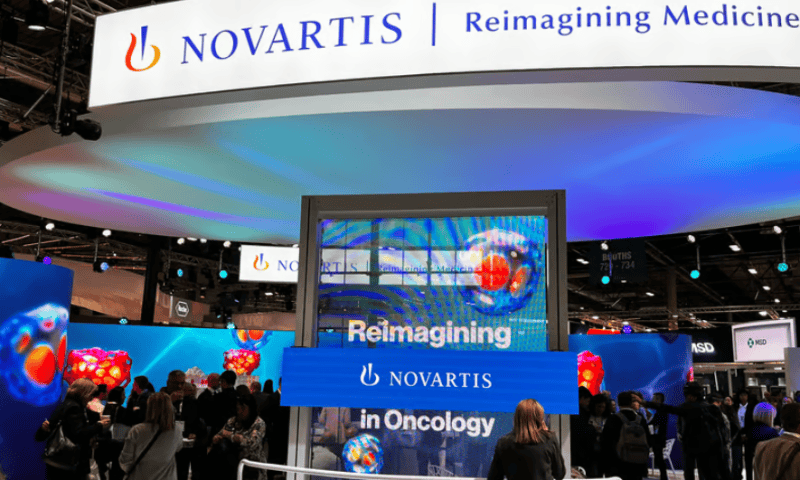MADRID — Novartis’ Jeff Legos, Ph.D., is watching peers like Eli Lilly move into radiopharmaceuticals. He knows what’s ahead for them.
Having overcome what the global oncology and hematology chief calls “manufacturing hiccups” after the approval of Pluvicto in 2022, Legos is confident the companies that are just now discovering the modality will have a tough time building the scale that Novartis has. The pharma also has Lutathera on the market for certain gastroenteropancreatic neuroendocrine tumors.
“We probably have a cumulative set of experience that spans a decade-plus, and, during that time, I think a lot of the important components of radiopharmaceuticals that had to be built, established at scale, are already in place,” Legos told Fierce Biotech on the sidelines of the European Society of Medical Oncology (ESMO) Congress in Madrid.
Lilly bought into the space earlier this month with the $1.4 billion acquisition of Point Biopharma. The biotech has a pipeline of clinical- and preclinical-stage radioligand therapies plus in-house manufacturing capabilities.
Legos isn’t worried. He’s confident in what Novartis has to offer and the challenges that lie in wait for companies that are just getting started now.
The platform itself is key. Companies need to decide which receptor to target, what their ligand or vector of interest will be and then how can this best be related to an imaging isotope or a therapeutic isotope, Legos said. Since acquiring Pluvicto through the $2.1 billion acquisition of Endocyte in 2018, the Swiss pharma has been focusing on garnering more approvals with a product Legos said has a high expression of a receptor called PSMA. The therapy is currently indicated for progressive prostate cancer.
The Big Pharma also acquired Advanced Accelerator Applications in 2017, which added the approved radioligand Lutathera to its pipeline.
“As we think about this strategy going forward, we are focusing on what we believe to be the most relevant, clinically validated and/or novel cell surface antigens by which we can deploy this technology to even more patients and more cancers using the same principle of delivering high dose radiation precisely to cancer,” Legos said.
To do that, Novartis has had to build up a massive manufacturing network. It didn’t go as smoothly as hoped, Legos admits.
“Yes, we have had some supply challenges earlier in the year, where we had some challenges forecasting what the true demand could be following approval, and through some manufacturing hiccups at some of our centers, we’ve had to overcome that,” he said.
Now, Novartis has facilities in New Jersey and is investing in expanded capacity in Spain and Italy as well as a new state-of-the-art facility in Indianapolis stateside. All this new capacity should handle demand from the approved indications and the ongoing clinical trials.
“If you think about the importance of manufacturing, it’s important to couple that with the logistics of the supply chain, because, ultimately, we are working against the clock from the day the order is sent,” Legos said.
Pluvicto has a radioactive half-life that requires, from order to infusion, about five days.
“So the manufacturing capacity, capability and logistics is something that Novartis and the legacy companies have really worked hard at to get to this point in time, and it will be difficult for others to be able to replicate at scale what Novartis has built,” he said.
Lilly clearly understood the manufacturing piece with its Point buy. The Indiana biotech came with an 180,000-square-foot radiopharmaceutical manufacturing campus in its hometown as well as an R&D center in Canada. There were also two lead programs in phase 3 that go straight to the heart of Novartis’ portfolio with indications in metastatic castration-resistant prostate cancer after second-line treatment.
Jacob Van Naarden, president of the Big Pharma’s oncology unit Loxo@Lilly, teased in announcing the deal that it was “the beginning of our investment in “developing multiple meaningful radioligand medicines for hard-to-treat cancers.” Prior to the acquisition, Lilly had invested in radiopharmaceuticals companies like Mariana Oncology.
Not just anyone can walk in and start working with a radiopharmaceutical. That’s another place that Legos thinks Novartis is ahead thanks to its two key acquisitions which provided a “head start” in the modality.
“It’s not easy to do, but it’s worth doing because of the benefit that we are observing with this therapy,” Legos said.
Novartis may not be done in radiopharmaceutical dealmaking, either. Legos said it continues to look for bolt-ons that could further leverage its existing capabilities and targets of interest. With three key components to a radiopharmaceutical therapy, he said the company is interested in all possibilities. Novartis’ “priority cancers” are breast, bone, prostate and gastrointestinal malignancies, according to Legos.
So as more companies move into radiopharmaceuticals, is Novartis eyeing the other hot item in biotech at the moment: antibody-drug conjugates (ADCs)?
Legos sees some similarities between the two modalities, but, ultimately, the company is focused on the highly tailored and precise radiopharmaceuticals space. Novartis instead thinks that Pluvicto could move into earlier lines of therapy sooner, despite the therapy posting mixed data in an earlier setting at ESMO.
“So at Novartis, we really aren’t focusing on trying to jump in on ADCs using traditional cytotoxic payloads,” he said. The company does have some radioligand therapies in the works “building upon the same principles” that have a very precise payload targeting a molecular pathway using a small molecule.
“If you look holistically across the industry at any of the ADCs, yes, they have shown benefit across some tumor types, but in general, they’re often reserved for later lines of therapy because of the overall benefit risk,” Legos said. ADCs come with gastrointestinal safety risks and interstitial lung disease—which has troubled AstraZeneca and Daiichi Sankyo’s follow up to Enhertu, Dato-DXd.

